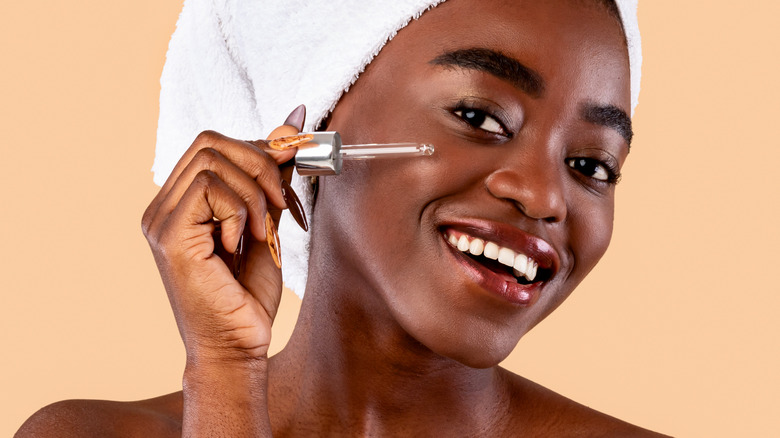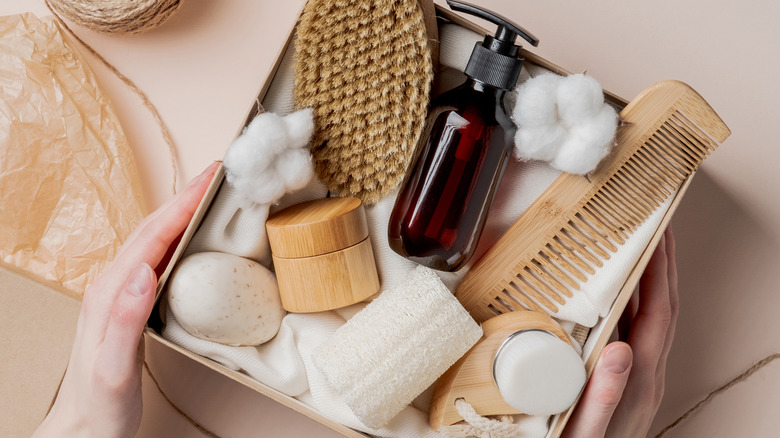Should You Apply Retinol To Wet Or Dry Skin?
We may receive a commission on purchases made from links.
In the world of skincare, retinol is the closest thing to a fountain of youth. Retinol, a vitamin A derivative and retinoid, has proven effective in unclogging pores, stimulating collagen production, and encouraging new skin cell growth, per Stanford Medicine. Retinol is included in a multitude of over-the-counter topical medications that have been shown to be successful in treating acne, minimizing wrinkles, and lightening hyperpigmentation. Given its versatility in enhancing people's skin texture and skin tone, this ingredient is a must-have antioxidant in many avid skincare fans' regimens as well as dermatologists' prescriptions.
As unparalleled as retinol is, retinol can be drying and its efficacy depends on how it's applied to the skin. Using retinol wrongly can make your skin red, flaky, and shedding. Retinol overuse might also cause "breakouts or inflamed acne that is not usual for your skin," says Dr. Shereene Idriss to Brides. When it comes to retinol, less is usually more, and "damp" doesn't equate to "hydrating." Now, let's take a look at how you can apply retinol for the best results.
You should apply retinol to dry skin
Since retinol has a tendency to lose its efficacy when exposed to direct sunlight, many dermatologists advise patients to apply a product containing retinol in the evening and wear broad-spectrum sunscreen during the daytime. After cleansing your face in the evening, gently pat it with a clean towel until it's completely dry. Dampness can affect the absorption of retinol through the skin and result in irritation, explains dermatologist Dr. Mona Gohara to StyleCaster. Moisturizers and serums work best on damp skin to seal in moisture, but not retinol.
This active ingredient can make your skin irritate really fast. Once your skin is completely dry, dab a pea-sized quantity of retinol onto your hand and spread it with your fingers over your entire face, beginning at the forehead where the skin is less sensitive and moving down to your nose, cheeks, and chin. Sharing with Dermstore, Dr. Joshua Zeichner recommends starting with the sparing use of retinol at first and gradually increasing the dose over time to let the skin adjust to the product. Retinol is not an instant fix for gorgeous skin. It might take several weeks to months before the results begin to show.
Other skincare products you can and cannot use with retinol
Although retinol is approved by the U.S. Food and Drug Administration (FDA), it's not without side effects, including dryness and flaking. Retinol irritation also occurs, usually within 24 hours, after you use a product that contains a high concentration of retinol. These signs of irritation usually dissipate after about a week. To minimize inflammation and make retinol more tolerable on your skin, you might want to buffer it with a soothing bland moisturizer at the same time as you use retinol, explains dermatologist Dr. Robert Anolik to Well + Good. Moisturizing ingredients such as hyaluronic acid and ceramides are safe to use with retinol.
AHA and BHA, skin exfoliants with powerful anti-aging effects, should not be used with retinoids at the same time and on the same day. Vitamin C, a powerhouse ingredient in its own league, is also not a good companion to retinol. Boasting different levels of pH, being layered over one another will decrease the retinol's pH and increase the vitamin C's pH, The Skin Care Edit cautions. The ingredients are both beneficial to the skin and should be used separately. To reap full benefits from these holy grail ingredients, use vitamin C during the day and retinol at night, or use them on alternate nights.
Retinol is a tried-and-true skincare ingredient that many dermatologists, facialists, and skincare devotees swear by. To make the most out of retinol and keep irritations at bay, however, it's important that you apply retinol products in moderation at night time when your skin is completely dry, and diligently wear sunscreen throughout the day. If your symptoms appear to worsen, stop using retinol and seek medical attention.


